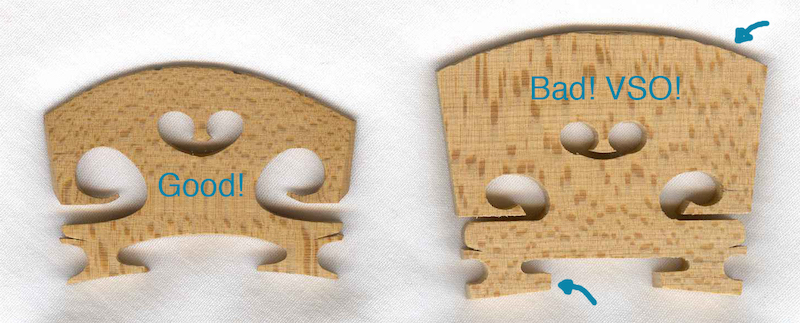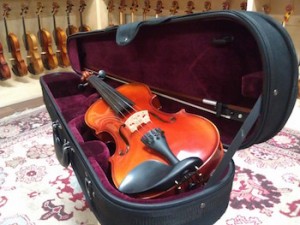Q:
If I decide to get a violin and mess around with it…
My first thought was to check local pawn shops, but I'm not sure what signs of “quality” or brands to look for – I might end up with something shoddy or discouraging in some other way.
Do you have suggestions regarding where I might get a decent quality violin for not a whole lot of money? (Especially if I later end up wanting to plug it into some electronics.)
Or should I just go dirt-cheap at first, see how it works for me, and then upgrade later?
Money isn't super-tight at the moment, but I don't want to spend more than necessary.
– Ben S
A:
Hey Ben,
The instrument you choose is going to make a huge difference.
A lot of people have come to me saying that they've tried violin and just couldn't get anywhere. They were ready to give up, feeling like there was something wrong with them, when in reality they were working with a violin that was nearly impossible to create a pleasant sound with.
Many violins at the entry level price range are literally unplayable even though they may look like a violin. The internet is full of them! These earned the nickname “VSO” which stands for Violin Shaped Object.
Looks like a violin, but it really isn’t!
You just have to be careful. Here are some general tips about price range, where to shop and how to spot a VSO.
Price Range
Resist the urge to “go dirt-cheap at first” — your hunch is right that a cheap violin could easily be discouraging.
That said, you shouldn’t have to break the bank for your first violin. I've found that $450 for a violin outfit complete with bow and case is the realistic entry level price for something that is good enough to learn on. Any less than that is highly suspect (unless it's some kind of great deal from a friend).
If your budget isn’t in the $450 range, your best alternative is renting. It costs $15-$20 per month to rent a violin of comparable quality, and a portion of the rental fee goes toward your future purchase. It's a fantastic way to give things a try without a huge investment. That said, you still have to make sure the rental violin is a good quality instrument.
From there I see a leap in quality at about $1,000 and then another leap at about the $2,500 price points.
So to wrap up:
-Rent for $20 per month until you're ready to spend $450
-Beginner outfit should be around $450
-Save up to get a $1,000 intermediate violin at about the 1-2 year mark
-Your dream violin may be $2,500 and up
Pick a Shop Carefully
Go to a dedicated violin shop.
General music stores that sell guitars and/or high school band instruments don't know violins. You'll pay too much for a violin that's poor quality or set up improperly.
I recommend Terra Nova Violins in San Antonio TX, 210-239-4700.
Tell them Jenny sent you! Have some patience and understand they are a small local shop, not an online mega store. You may have to call a couple times and nudge them along. You don't want a violin that's a stock item off a shelf anyway.
Their instruments are worth it and they always take excellent care of my students.
Now that I’ve (hopefully!) convinced you that your first violin should not be the “bargain basement” variety, let’s talk about how to get the most bang for your moderate buck.
How To Know You’re Looking at a VSO
Ah, the dreaded “Violin Shaped Object.” Looks like a violin. Might even smell like a violin. Certainly doesn’t sound like a violin. Here are a few dead giveaways:
Bridge Feet
Look at the photo below (the VSO is on the right). The feet of the bridge of the VSO are thick and rectangular. Also notice that the curve of the bridge is symmetrical. This is a blank bridge that has not been set up. The chunky rectangular feet do not efficiently transfer the vibration to the top of the violin so it will be easier to squeak and the sound you produce will generally be thin. The even curve will make it hard to play the E string without hitting the A unintentionally, which is very frustrating, and playing on D and G strings will be weird too. Not to mention, if a violin is sold with a bridge that looks like this, there is a good chance the rest of the violin is junk.
 In contrast, the bridge on the left has been carved and customized by an experienced luthier. Notice the feet are curved and very thin. These have been masterfully customized by a luthier to fit the specific violin. The curve has been artfully shaped to allow easy string changes, including a steeper slope down toward the E string. There is a good chance that you are looking at a decent instrument if this kind of attention has been given to the bridge set up.
In contrast, the bridge on the left has been carved and customized by an experienced luthier. Notice the feet are curved and very thin. These have been masterfully customized by a luthier to fit the specific violin. The curve has been artfully shaped to allow easy string changes, including a steeper slope down toward the E string. There is a good chance that you are looking at a decent instrument if this kind of attention has been given to the bridge set up.
Fingerboard
The VSO fingerboard can be made of a soft wood and painted black to imitate ebony. Look under the fingerboard for gaps in the paint. A real violin will be solid black underneath because it is solid ebony.
Purfling
“Purfling” is a fancy word for the very thin strip of inlaid wood around the edge of the body of the violin. Purfling protects the violin body from temperature changes and is a sign of good craftsmanship. VSOs do not have purfling, but rather might have a thin strip of paint to imitate purfling.
Tuning Pegs
A VSO’s tuning pegs can be made of a softer wood and often are not fitted properly to the instrument. This makes it very easy for them to slip. If your violin, or the one you are looking at, goes constantly out of tune, there’s a good chance it’s a VSO.
Strings
Cheap strings sound tinny and harsh. The good quality strings that come with a good violin cost $25-$50 per set and this is part of the value you get when buying something good.
BSO
Only thing as frustrating as a VSO is a BSO: “Bow Shaped Object.” Ironically, BSOs often are not bowed enough and will appear somewhat straight. Or it will bow in the wrong direction curving side to side. You can also sometimes notice sloppy connections where the hair meets the bow.
It’s amazing, but a bow is just as important as the violin!
If you encounter one of these objects I suggest using it for backyard baseball or as a backscratcher, but minimize trying to use it to learn violin!
Location, Location, Location
The store you buy from makes the biggest difference.
I haven’t found any online dealers I can recommend wholeheartedly. Early on in my learning journey I had a $1500 violin from Shar which is a reputable online dealer.
It ended up having a strange problem where the finish was tacky and never fully dried. I ended up getting one from Terra Nova that sounded way better and cost only $1000.
After that experience I've gone local and never looked back.
And like I said before, also avoid music stores that specialize in guitars or school band instruments – their violin selection is likely to be a gorgeous array of VSOs.
Signs of Quality and “Good Brands”
It's not like a guitar where you can buy a good brand and know what you're getting. This is because it's relatively easy to mass produce a good quality guitar. Not so for violin!
You can't tell what you will get based on brand name alone until you get into the very high price ranges of makers.
It’s easy to give a checklist for spotting a VSO (what not to buy), but the only way I know to get the very best for your money is to use a personal connection. Shop extensively with an experienced violinist or find a dedicated violin shop that you trust. I trust my friends at Terra Nova Violins the most, so I send people there.
Another good way to find the best violin shop local to you is to call your nearest symphony and ask where the symphony members go.
Good luck!
Keep me posted,
Jenny





